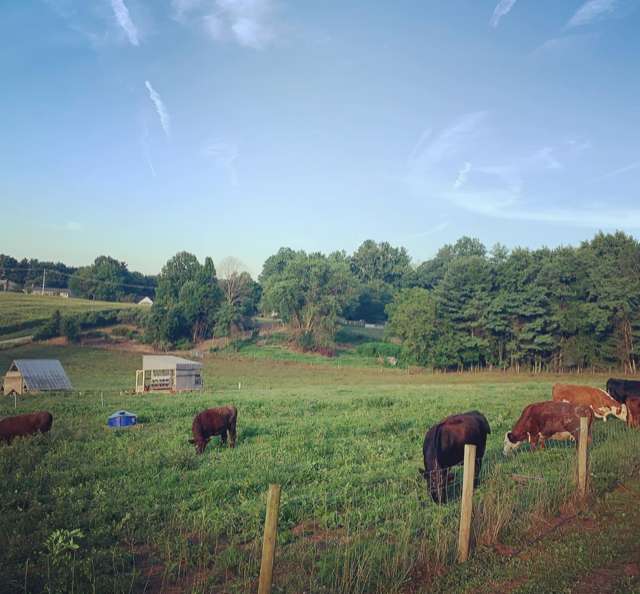Pork Trotter Broth & Split Pea Soup
posted on
January 25, 2022
Pork trotters (also known as pig feet) create a richly flavored packed broth when slow simmered with aromatics of your choice. I chose to keep it simple with my aromatics in order to have a more versatile pork broth, but already looking forward to my next batch where I'll try with the addition of ginger, leeks, extra garlic and mushrooms. You can really get creative with this one!
Pork broth is not very common on the grocery store shelves, but it should be! More of a deep, intense flavor than chicken broth, but can be used in its place in many recipes. It would be great for making pot pies (even chicken!), for simmering veggies, amping up the flavor of many dishes including rice and especially in soup. The first soup we decided to make was split pea and ham soup. This soup is one of my personal favorites, but I had always previously made it with chicken stock. Without a doubt, the pork stock was the key to making my soup even better than usual. Make sure to keep reading for that recipe!
If you aren't used to cooking with pig feet, it may seem a bit strange at first. Don't let looks intimidate you, once you get them in the pot, you have already won! The next time you see them, straining your beautiful broth, it will be a simple pile of nondistinctive bones. It is SO worth it, trust me!

Where to store your dream-worthy pork stock? You have three options; refrigerator, freezer or shelf. It can be kept refrigerated in an airtight container for up to a week or frozen for 4-6 months. If you plan to freeze, just make sure you leave ample headspace to allow for expansion. Lastly, it can be pressure canned for shelf storage for up to a year; pints for 20 minutes and quarts for 25. The positive to this is that it frees up freezer space and is ready to go at a moment's notice without worrying about time to thaw. The downside, however, is that there are studies that have proven the great amount of heat used to pressure kills some of the beneficial nutrients.

To make pork trotter stock, first remove thawed, refrigerated trotters from packaging and place into a large stock pot. I used a narrow 16-quart pot and it was plenty of room. Bring to a gentle boil over medium heat. It is recommended that you dump this first batch of water after the initial quick blanch and refill with fresh water.

Once water has again reached a gentle boil, skim any bubbles or residue that floats to the top for the first 30 minutes without stirring. Reduce heat to medium-low and allow to gently simmer uncovered for another 4-5 hours. At this point, the smell will become more savory and you can gather your aromatics.
Aromatics are where you can really make this your own. I wanted something versatile enough to use as a replacement for chicken stock so I went with carrots, onion, celery, lots of halved garlic cloves, three bay leaves, black peppercorns, salt and a touch each of sage and turmeric.
Toss your carrots and onion with some fat or oil and toss into the oven preheated to 425-degrees. Roast until they begin to char, then add to the stock pot along with celery, garlic and anything else you'd like. This is a great time to use up any produce scraps like celery leaves, carrot tops and fibrous scallions. Stir well and continue to simmer for another 6-18 hours. You will need to top off with water at least once, or as often as you wish, according to your preferences. It is recommended to not add water with less than an hour of cook time remaining. I chose a very dense, reduced version and totaled 4 quarts of final, canned stock. The volume that was left in the pot at the end was 8 quarts, meaning I strained approximately 2 quarts worth of bones, skin and vegetable scraps.

In order to extract the greatest amount of vitamins, minerals and nutrients like collagen, time is key. I highly recommend not pulling the stock before 12 hours, and the longer you let it go, the more flavorful and nutrient dense it will become. Check out this picture of 24-hour stock refrigerated for 30 minutes...that's some seriously collagen-dense stuff!

The next step is the most hands-on yet; straining your gorgeous liquid gold. You can start setting up once you remove the stock pot from the heat. Doing this in the sink is ideal, as splashes are bound to happen. At the base you will need a large, heat-shock resistant glass or ceramic bowl. On top of that, a wire mesh strainer and on the very top, a larger colander. With a spoon, remove large chunks from the stock pot and discard. Then pour through the strainers, being careful to not overflow your bowl.

Rinse the wire strainer and line with cheese cloth. Strain broth once more through this, ideally into a large, spouted measuring bowl. I snapped this next photo before the final strain, and silly me forgot to get a gorgeous shot of my finished jars of stock. Pretty sure I was just too excited to get the split pea soup going!

Did you notice that beautiful fat at the top? I prefer to leave fat in my stocks for various reasons, but this was is a lot! Good thing I planned on using the fat to start my next recipe, so didn't take any off. Instead, while filling jars, I simply set aside the first jar (way more fat than the others since most of the fat pours off initially) to cool as quickly as possible. Again, because I was just too excited for that soup.
If you wish to remove fat before filling containers, you could simply skim with a ladle or fill with a fat separator. Otherwise, you could refrigerate it (once allowed to come to room temp first) and pull the hardened fat chunks off.

Alrighty, on to that soup! The meaty, bone-warming pot of Split Pea and Ham goodness coming to your stove-top soon...
With this recipe, soaking the split peas is not required. However, a couple good mini-soaks are! Rinsing and checking for stones is always a must, but I've found that allowing them to be submerged in water for just a few seconds at a time really helps for a better soup. It better rids them of residue while also removing a lot more of the skins which can add a lot of unwanted texture to the final dish. Once they're submerged, just whoosh them around with your hands to help kick off the skins before a sudden flush, rinse and repeat. Below you'll see the first (you can't even see the peas!) compared to the third and final rinse.


Next, you'll want to prep your vegetables and herbs. Onion and celery can be roughly chopped. I like to have visible hunks of carrot left once the soup is done, so I cut those larger than usual, about 3/4" thick. Mince the garlic, combine herbs and seasonings (except smoked paprika) in a small dish.

Finally, break down the ham slice. Remove the bone and set aside. Slice off the smoky rind and dice. Cut out any very fatty sections and chop finely (outlined in blue). Dice the rest of the ham and set aside, covered.

Heat a Dutch oven or other heavy-bottomed pan over medium-high heat. Add 3 Tbsp. pork fat (reserving one) along with onion, carrot, celery and ham trimmings. Stir well for 3-4 minutes.

Add garlic, salt, pepper, thyme and sage. Stir continuously for another minute.

Add 4 cups pork broth, water, ham bone, split peas and bay leaves. Bring to a boil, stirring often.

Once gently boiling, reduce heat to low, cover and allow to cook undisturbed for 30 minutes. Meanwhile, heat a large skillet over medium-high heat with 1 Tbsp. pork fat. Scatter diced ham in the hot oil and season with smoked paprika. Allow to sear before stirring once and turning off the heat.


Once the 30 minute timer is up, add ham and stir the soup well, being sure to scrape the sides and bottom of pot. Add 2 more cups of pork broth and chicken base; stir well again to incorporate. Increase heat to medium-low, cover and cook for another 45-60 minutes; this time stirring occasionally. The peas will eventually cook down to a smooth consistency with stirring that you will have no need to use a blender. You may choose to add more water to further thin the soup. If you would like to thicken the soup, simply cook a bit longer uncovered.

Season with salt and pepper to taste. I like to finish this soup with white pepper but this is not necessary. A hot bowl topped with freshly-cracked black pepper is just as divine. Serve with warm crusty bread or croutons. Enjoy!
Click this link to see the full recipe:




